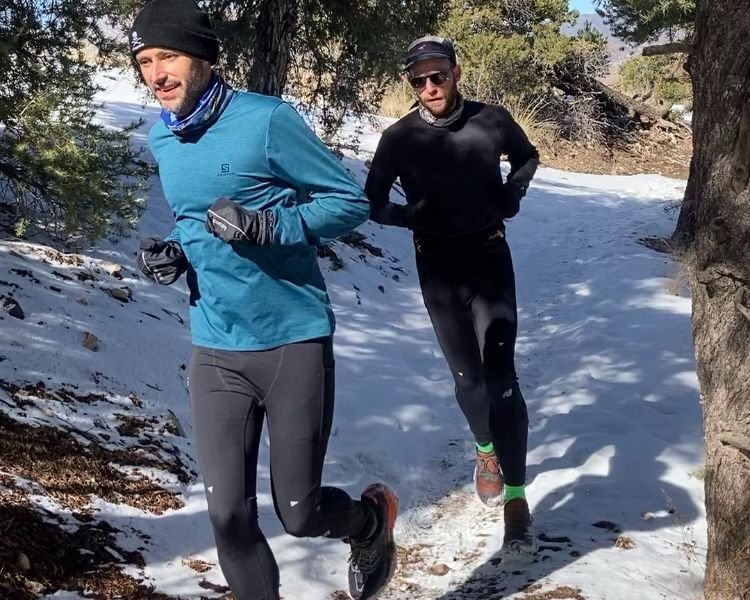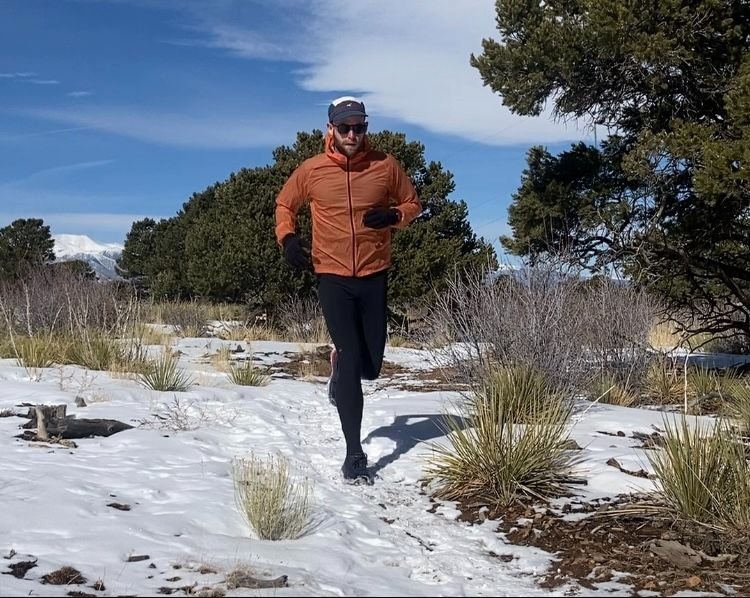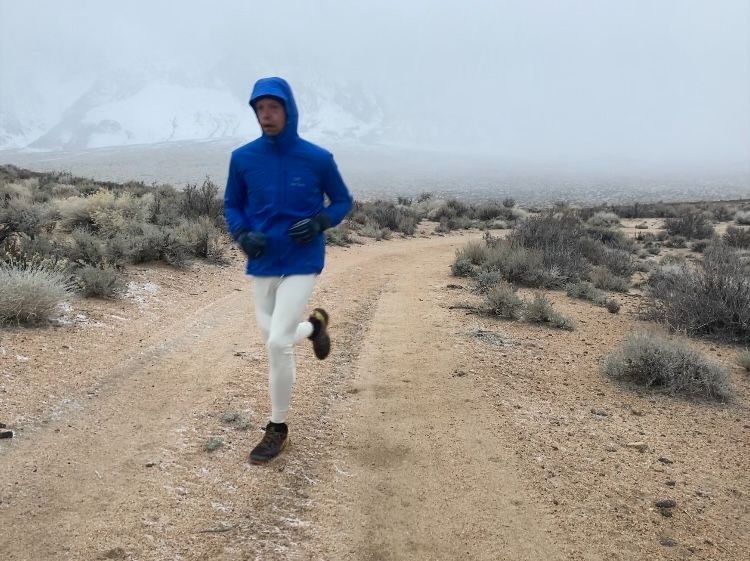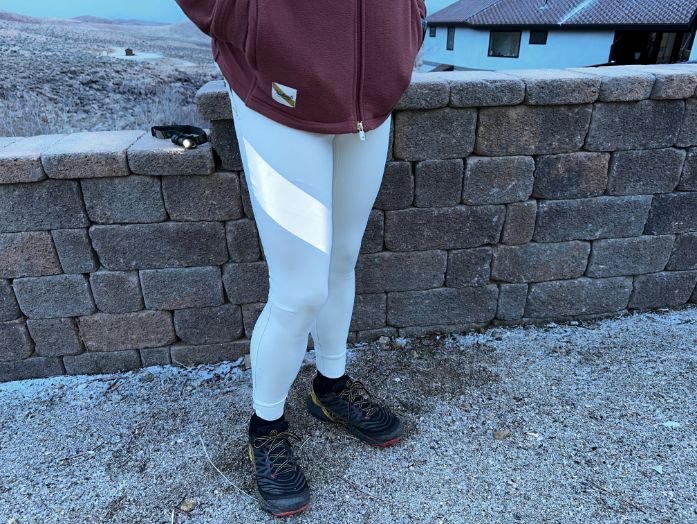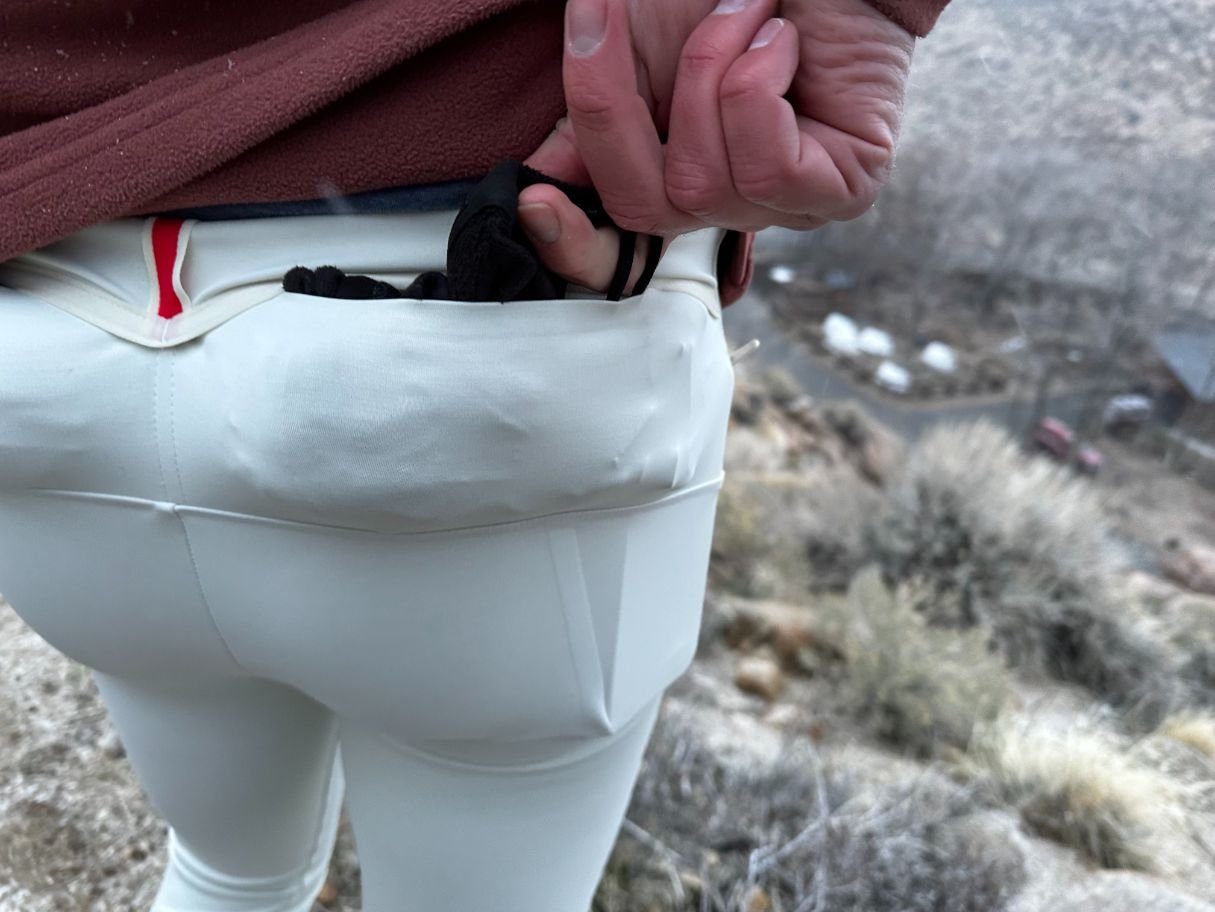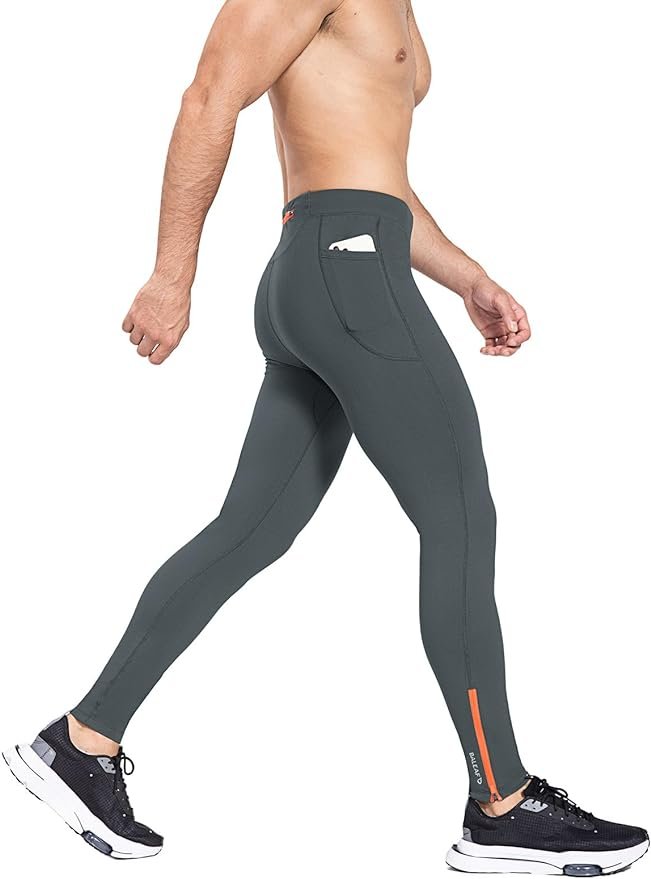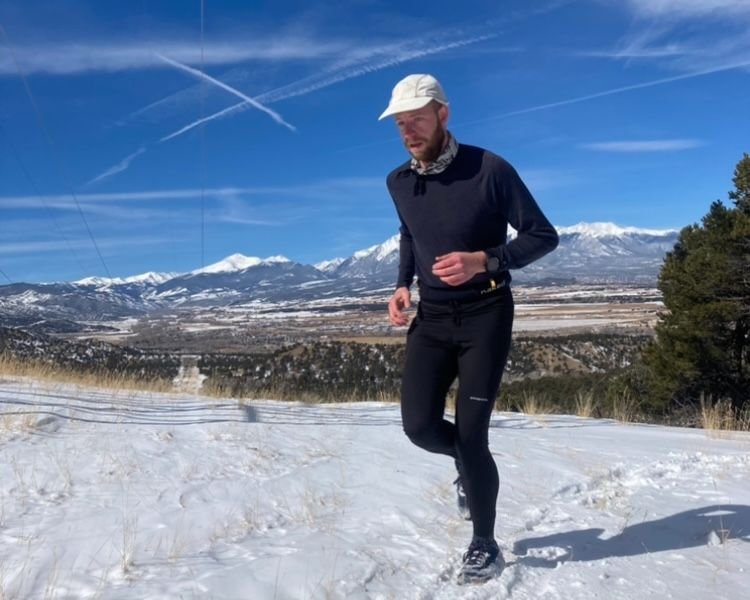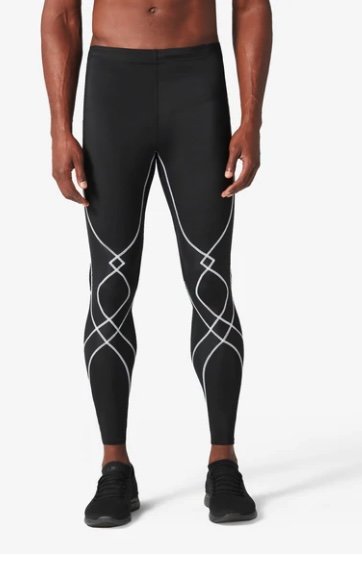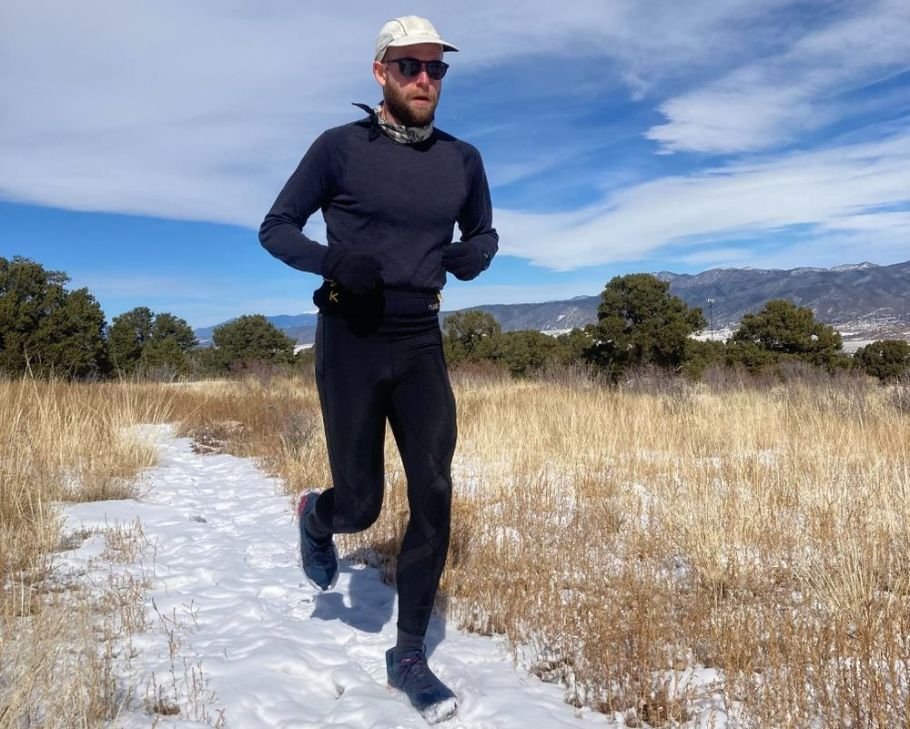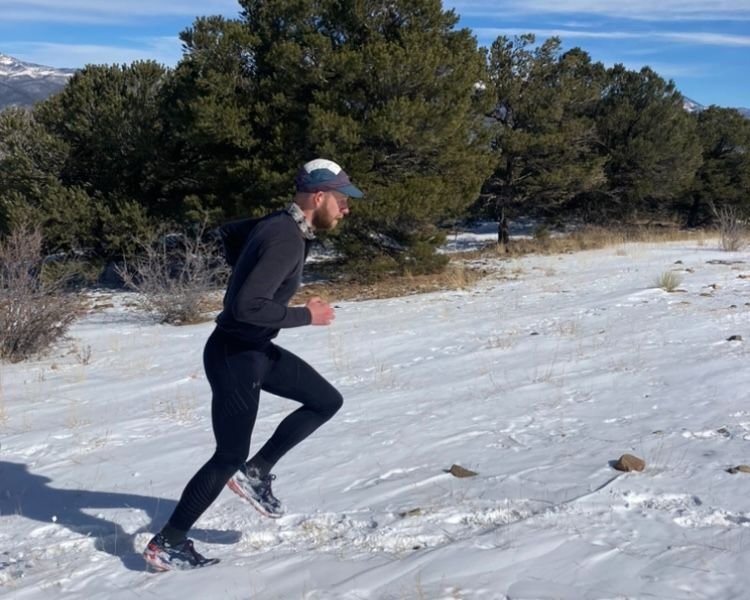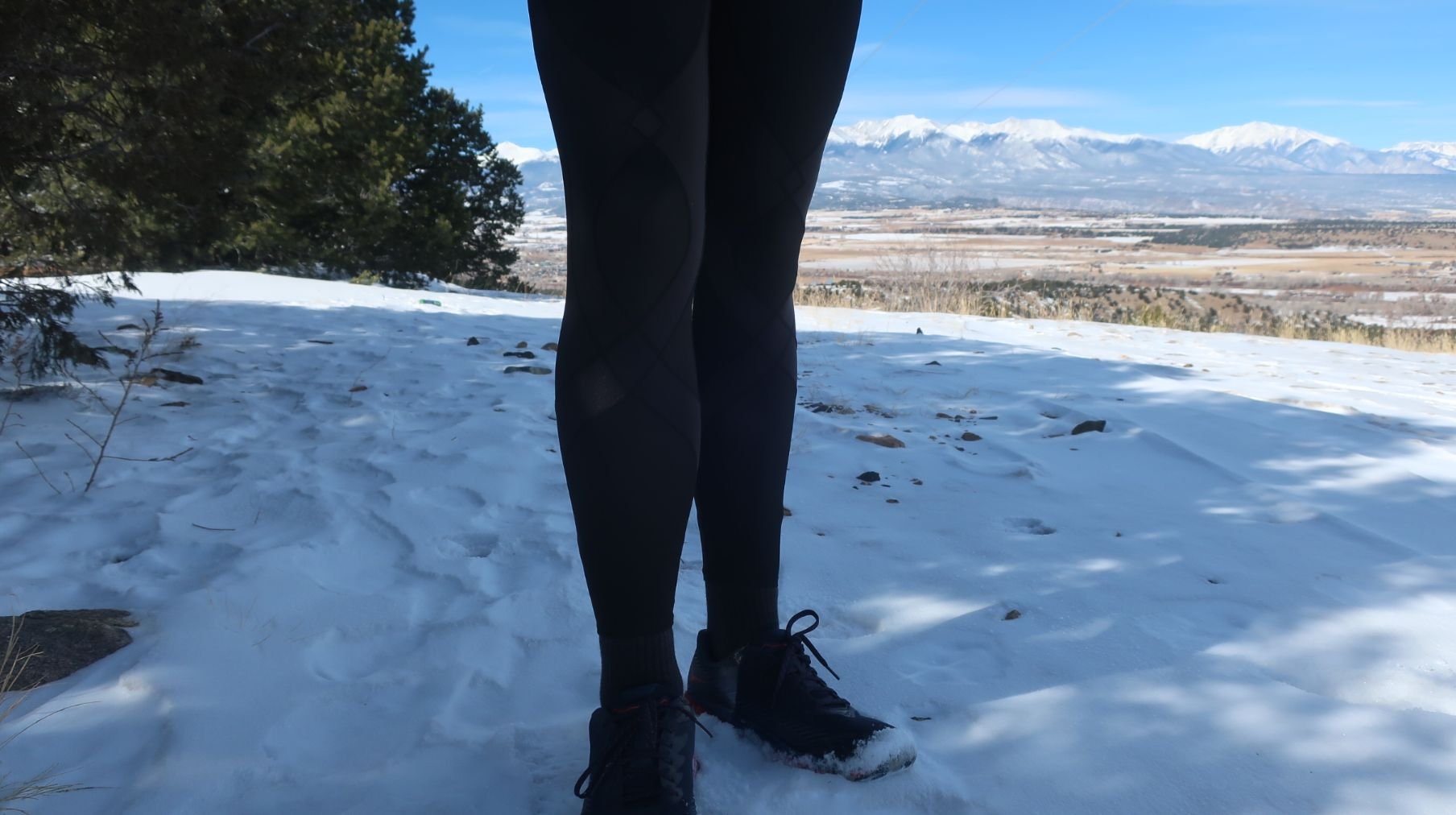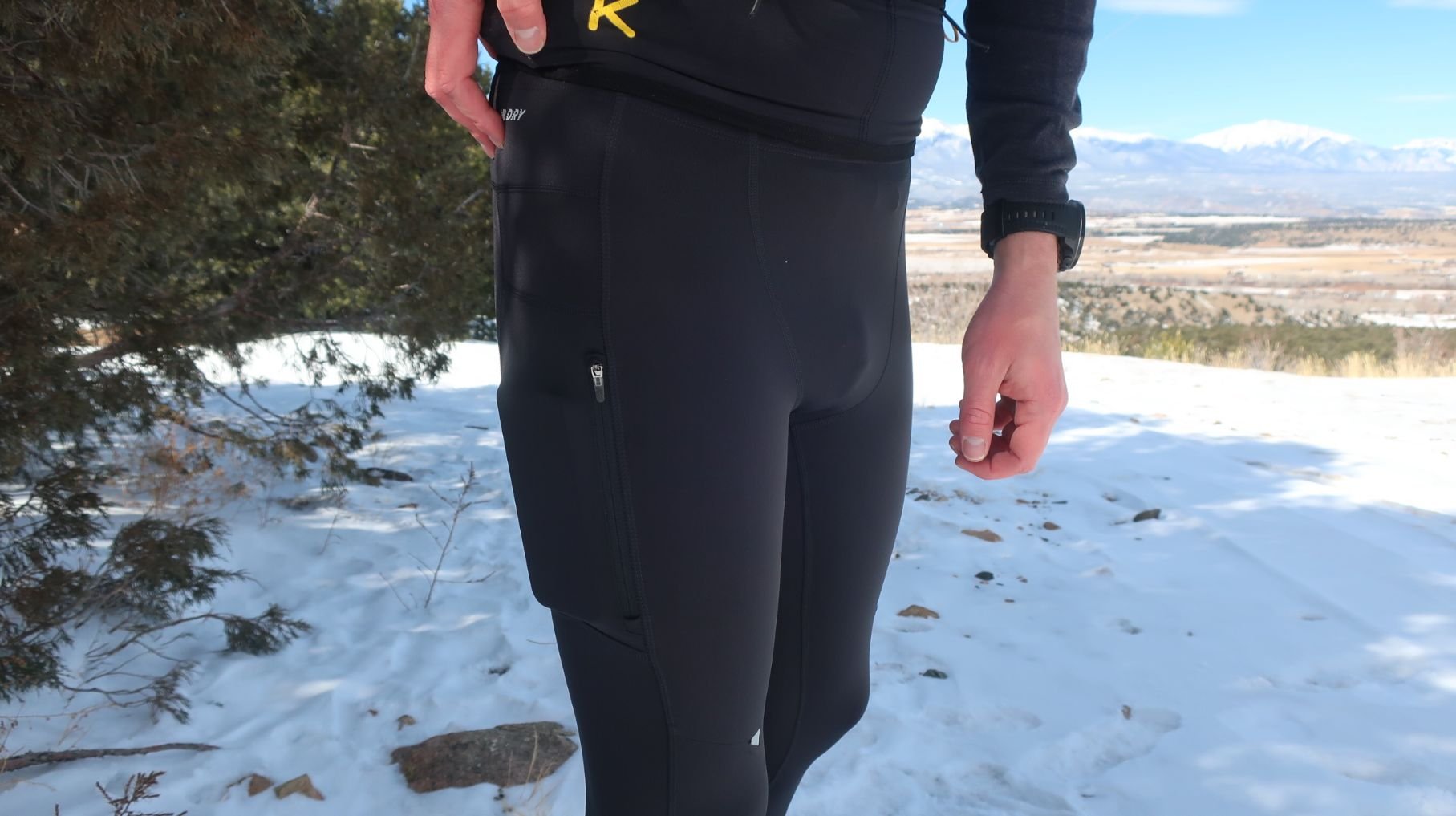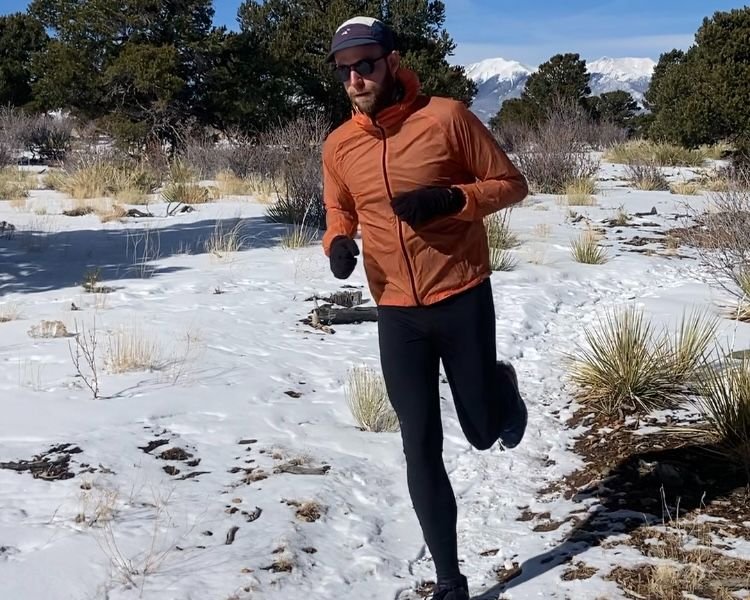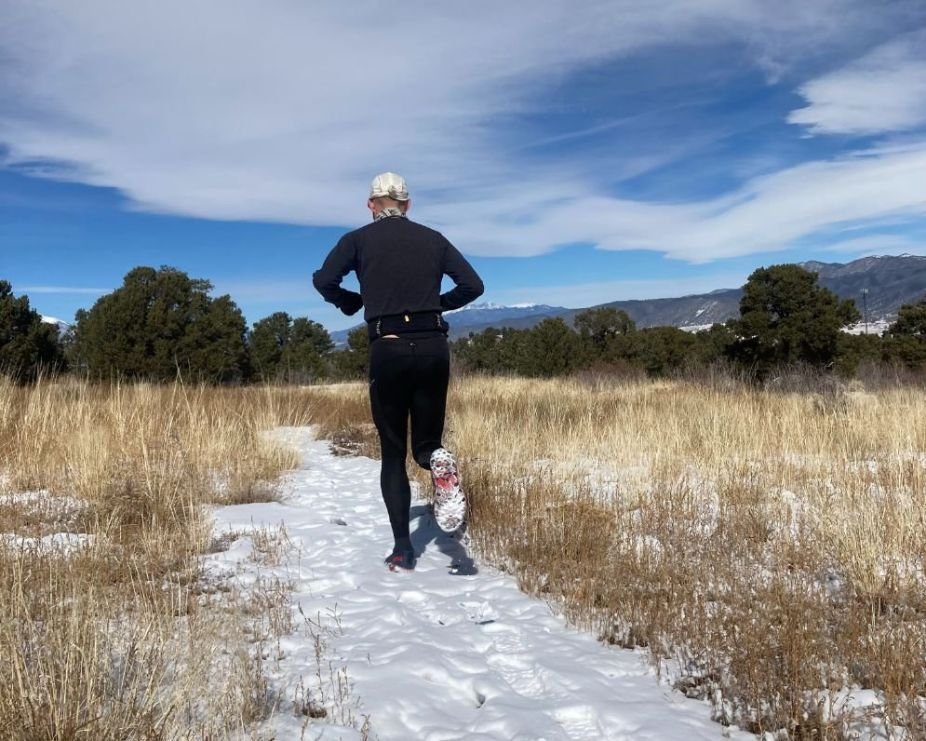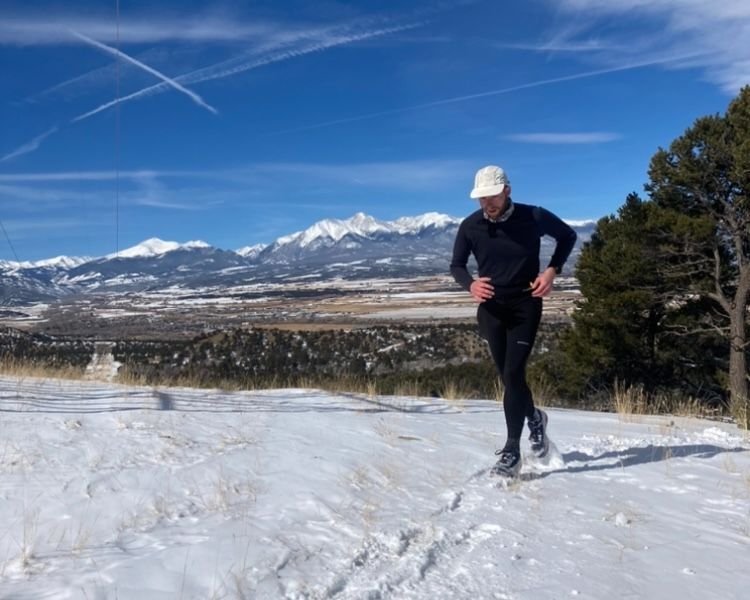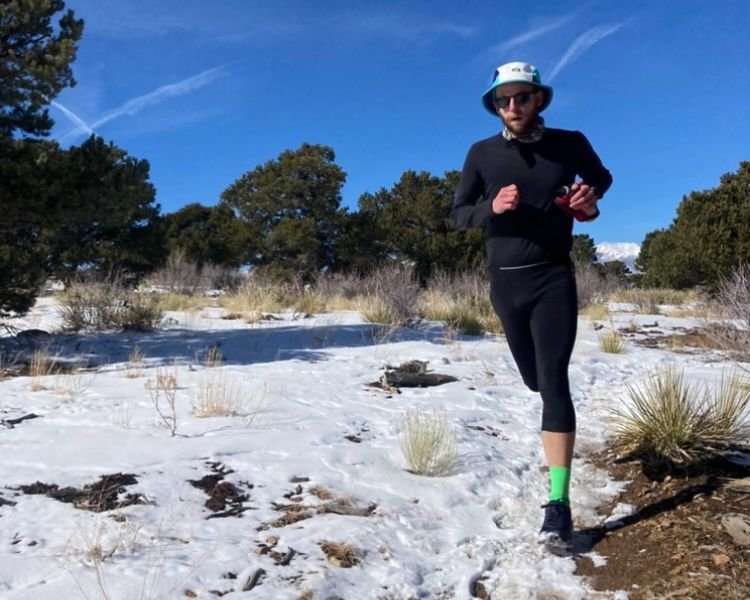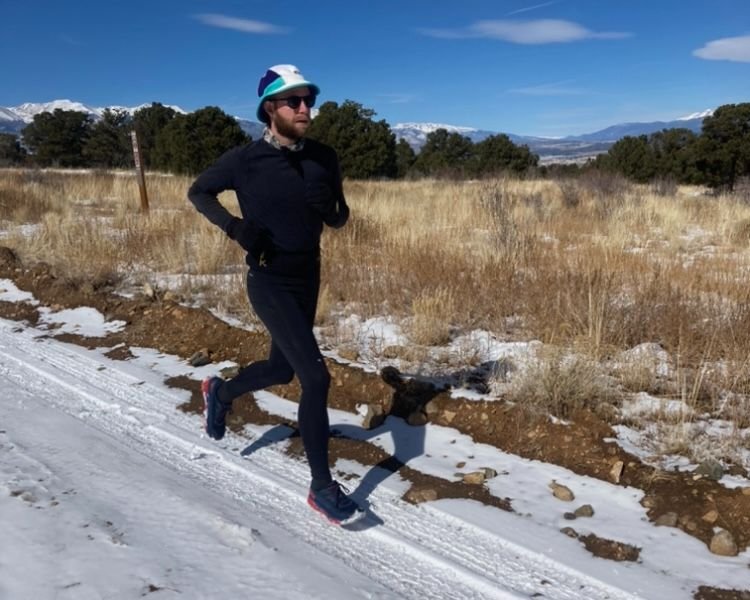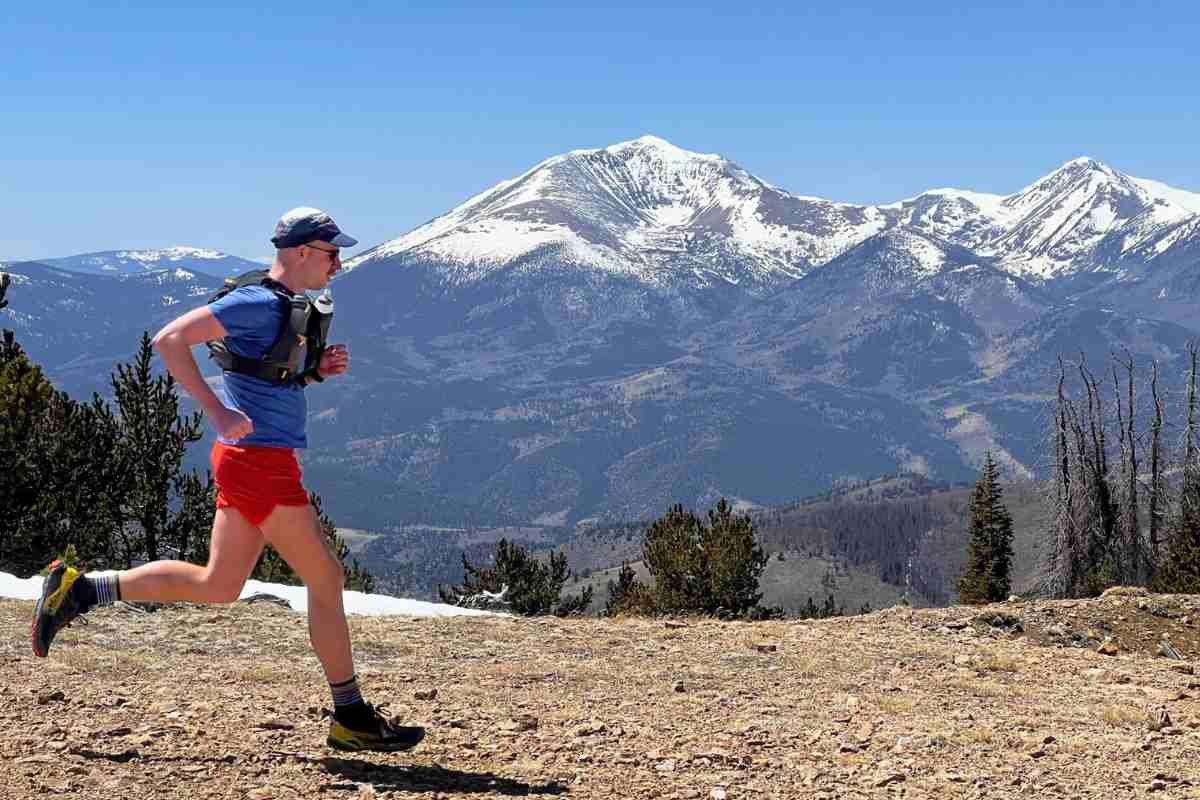Best Men's Running Tights of 2025
The Top Men’s Running Tights, Leggings, And Pants For Mild And Cold Weather
October 16, 2024
Home > Gear Reviews > Running
Cold weather running highlights the importance of dressing for the conditions: time in the dark, cool temperatures, and sometimes even rain and snow. While classic jogging pants or running pants may feel sufficient when heading out the door, running is a high output activity, and we sweat in all seasons. Running tights assist in wicking away water vapor (sweat) so it can transfer to the outer parts of the garment and evaporate, keeping the runner dry, warm, and safe.
Investing in an excellent pair of running tights can play a crucial part for runners who hope to stay comfortable and motivated through the winter. Running tights vary in fabric material, insulation level, style, and construction, so we’ve tested various types in the chilly high country of Colorado and eastern Sierra in California to decide on the best running tights for men everywhere.
We tested 15 of the most popular tights to found the best men's running tight–with a secure waistband, five pockets, and comfort.
Looking for women’s running gear? See our Best Women’s Running Tights
Prefer pants or joggers? See Best Running Pants and pair them with Best Men's Long Underwear
We create reader-supported, objective gear reviews independently selected by our editors. This story may contain affiliate links, which help fund our website. When you click on the links, we may get a commission, without costing you an extra cent. Thank you for supporting our work and mission of outdoor coverage for every body! Learn more.
Comparison Table for The Best Men's Running Tights
| RUNNING TIGHTS | TREELINE AWARD | MSRP* | SIZES | INSEAM | POCKETS | REFLECTIVE? | MATERIAL |
|---|---|---|---|---|---|---|---|
| Janji Trail Tights | Best Men's Running Tights Read why |
$98 | S-XL | 28" | 2 | Yes | 68% nylon, 32% spandex |
| Tracksmith NDO | Best Reflective Running Tights Read why |
$200 | XS-XXL | 28 - 30" | 3 | Yes | Body: 35% Lycra, 33% Polyester, 32% Nylon. Lining: 67% Polyamide, 24% Elastane Lycra, 9% Polyurethane |
| Baleaf Men's Winter Running Tights | Best Budget Running Tights Read why |
$40 | S-3XL | 29 | 3 | Yes | 82% Polyester, 18% Spandex |
| Patagonia Wind Shield | Best for Extreme Cold Layering Read why |
$179 | XS-XXL | 32" | 2 | Yes | 68% recycled nylon, 15% polyester, 17% spandex |
| Patagonia Peak Mission Tights | Best for Cool Weather Read why |
$129 | XS-XXL | 32" | 1 | Yes | 68% recycled nylon, 15% polyester, 17% spandex |
* Prices reflect MSRP at time of publishing and are subject to change. See our Deals Page for discounts and sales on products that win our awards.
The Best Men’s running tights
The Best Men's Running Tights Overall: Janji Trail Tight
Material: 68% Nylon, 32% Spandex
Sizes: XS-XL
Inseam: 29”
Pockets: 5
Reflective detail: Yes
Best Season: spring, fall, winter
What we liked: warmth, comfort, fit, light compression, forgettable in the best way possible, side pockets are large enough for the largest phone sizes (including the case)
What we didn’t like: drawstring could be longer
The Janji Trail Tight are the best overall men’s running tights that give you all the warmth, the fit you need, and are forgettable in the best way possible. The Trail Tights have consistent light compression throughout, a slightly looser fit at the hip, and dual-layered front panel for modesty. Most of our runs in these light compression tights averaged about an hour, but some were up to two hours with varying intensity levels. Through these, the Trail Tight was forgettable in the best way possible through all parts of our runs.
Janji listened to customer reviews and other feedback from their original Groundwork Tights design, with common complaints about the waistband sagging. The result is a secure stretch band, with an internal drawcord made with a forgiving, internal stretchy drawstring.
Compare prices of the Janji Trail Tight
The Janji Trail Tights are comfortable even without shorts. Photo by Justin Walker
Comfort
These leggings were comfortable without shorts given the double-lined front fabric. We found these tights the most modest when heading to the market for post-run dinner on sunset runs and the coffee shop after morning weekend efforts.
Features and pockets
The Trail Tight has the external features covered, too, with a total of five pockets: two small interior pockets, a pass-through pocket on the back fit for gels or a light jacket, and two-layered pockets of varying sizes on each hip. Janji also includes an S-biner to secure your keys.
The side pockets on the Janji Trail Tight were secure and will fit most phones well. There’s reflective tape integrated into the side stitch here that’s only visible at night. Photo by Justin Walker.
These side pockets were the big winners, similar to the Patagonia Mission Tights we tested. They were oversized enough to accommodate the largest phone with a case on one side and a pair of gloves and warm hat on the other—one could even toss in a pair of headphones if desired. We found these pockets secure when in use, yet out of the way functionally and aesthetically when empty.
Regarding safety, the Trail Tight incorporates a reflective logos on the front and back of the tights.
Warmth
The Janji Trail Tights aren’t the warmest tights available for winter running, but they’re adequate for winter running conditions that most of us may find ourselves in. Our reviewer tested these at temperatures down to 9°F with no wind at sunset, to 30-50° F with 15-20mph winds.
The tights let the cold in at around 12° in calm weather and about 30° with winds. For us, pulling on a pair of overpants like the Patagonia Wind Shield pants bridged the gap. This also makes them the ideal pair for spring or fall when it’s too chilly for running shorts, but doesn’t require a lot of insulation.
As the best running tight, there’s not much we didn’t like about the Janji Trail Tights, though the drawstring is a little on the short side, sometimes making it difficult to tie a knot.
Material
It's made with bluesign approved material and made in a Fair Trade Sewn factory that ensures workers have a higher-quality of working standards.
The bottom line
The Trail Tights are an excellent blend of comfort and warmth, flat seams expected in quality tights, and inspire a sense of durability. If you’re going to own a single pair of tights for shoulder season conditions, the Trail Tights will do the job through most winter conditions.
Best Men’s Reflective Running Tights: Tracksmith NDO Tights
Material: Body: 35% Lycra, 33% Polyester, 32% Nylon. Lining: 67% Polyamide, 24% Elastane Lycra, 9% Polyurethane
Sizes: XS - XXL
Inseam: 28” - 30”
Pockets: 2 x Envelope, 1 x zippered
Reflective detail: Yes (the most)
Best Season: Late fall through early spring
What We Liked: 3M Reflectivity, warmer than most tights, comfort, and smart, functional pockets
What we didn’t like: Not the most affordable on our list. Lack of drawstrings may not be ideal for everyone.
We’ve been searching to test a reflective and hi-visibility-focused pair of men’s running tights that don’t skimp on performance elsewhere. During our winter testing in the eastern Sierra, we found the best reflective men's running tights in the Tracksmith NDO Tights. Unlike other tights that delaminate reflective material, Tracksmith's reflective material stays put. The pockets also rank among our favorites, second only to the deep side pockets found on the Janji Trail Tights and Patagonia Mission tights. For these reasons, we awarded the Tracksmith NDO Tights the Best Men’s Reflective Running Tights and recommend them in our Best Reflective Gear for Running in the Dark guide.
View the Tracksmith NDO Tights
The Tracksmith NDO tights' reflection showing up under the light of a low evening storm light and a phone camera flash. One reflective sash up front. One sash on the rear leg. Photo by Sasha Hashemipour
Reflective features
Being seen is an important factor for many runners valuing safety on the roads and roadside trails, especially those heading out in low-light areas (both in urban and less pedestrian-friendly rural areas). In the colder months, days are shorter, and more people start or end their days running in dark or low-light conditions. If we stick to our running schedule, sometimes running in the dark is the only way, and Tracksmith recognizes this.
Working to improve upon former quality control issues with reflective delamination, Tracksmith paired up with 3M to produce a 360° visibility stash on the front right thigh and back left calf.
Warmth
The warmth is on the average-to-warmer-than-average side. The tights have a wet-suit-inspired comfort, meaning they have some noticeable compression
Our legs are the primary movers when running, so it only makes sense that they have some reflectivity to act as a bright, moving flag for cars in the area. The 3M sash on the legs of the NDO tights is the most bright that we’ve tested. We could even notice it in the mirror the first evening that we donned them before a run in the mid-20s Fahrenheit.
Speaking of temperatures, Tracksmith markets these tights as harsh weather winter tights, incorporating a double fabric that runs down from the waistline over the front thighs. We tested this in an open area at the base of the big Eastern Sierra mountains, where we get cold sunset winds from the higher elevations in the north.
Running in the Tracksmith NDO running tights in 22°F with 25 mph winds. Winter storm blowing in from up high. Photo by Trey French
Wind protection
There is a noticeable difference in front and back wind protection. With other tights, we sometimes come home with numb thighs when the temps are below freezing with wind. Not with the NDOs. That said, though we appreciate the double fabric, we don’t necessarily recommend these tights as a sole layer for consistent temperatures in the teens, especially if those temperatures include wind and no sun. In those conditions, we’d still recommend layering with running pants worn over these tights.
Pockets
The NDO Tights have three pockets: 2 x envelope pockets and a zippered pocket. The envelope pockets are easy to add and remove items from but also feel secure, relying on the tension of the fabric against your body. We could fit our usual easy run-from-home stuff in there, including our phone, lightweight fleece gloves, house key, and compact headlamp. If you want to carry water, you’ll need additional storage like a handheld, running belt, or vest. Our reviewer almost always carries a running belt on short runs but can go without when wearing the NDO Tights.
The Tracksmith NDO features a large reflective strip for added safety and security while running in low light. Photo by Sasha Hashemipour
Fit and comfort
Our complaints were minimal when testing the NDO Tights, but we’ll explain some things to consider. The NDO tights are wet-suit inspired, which we found to mean that they have some light compression. Not as much as found on the CW-X Stabilyx Joint Support Compression Tights (review below), but more than the Janji Trail Tights (review above). While digging around customer forums and community boards, some people mentioned that the NDOs felt slightly smaller than their stated size.
We did feel that they were a little tighter than some when putting them on at first (we also appreciate the zippered ankle closure because of this), but they were never uncomfortably so while running. We could tell the sizing was correct because they didn't slip down during a run, which can sometimes happen with too small tights. Instead, the NDO stayed put.
Pocket design on the Tracksmith NDO running tights. Here, they are shown fully loaded with essentials. Photo by Sasha Hashemipour
There is also no drawstring adjustment on the NDOs. We didn’t have a problem with this, and we haven’t seen anyone else mentioning it, but we could see it being an issue for someone with a small waist for their size relative to their hips or legs. Lastly, we noticed a high percentage of elastane at 24% for the liner. While we had no problems with the tights wicking sweat, elastane is not known for being the best at that. The 67% of Polyamide could offset it in the liner. Wicking and wetsuit comfort!
The bottom line
Despite these minor grievances, the NDO has much to offer, and it will keep you seen by cars and other people out there during your low-light runs. We’d love to see the level of reflectivity on the NDOs on more tights; however, we also recognize production requirements, added costs, and potential consumer desire for more mellow aesthetic tights. With all critical performance qualities considered, the NDO is a worthy consideration for your winter wear out on the road or trail.
Best Affordable Running Tights: Baleaf Fleece Lined Running Tights
Material: 82% polyester, 18% Spandex
Sizes: S-3XL
Pockets: 3 (2 side, 1 back zippered)
Inseam: 29”
Reflective: Logo only
Best season: Spring, fall, winter (designed for 20 F to 50 F)
What we liked: light compression, windproof, value for price
What we didn’t like: minimal reflective detail, pockets are small
The Baleaf Fleece Lined Running Tights are our winner for Best Budget Men’s Running tights for delivering a balance of performance features we want at a more affordable price.
Baleaf is an affordable brand that shows up in many of our guides as best budget winners, including Our Favorite Insulated Pants. They often tick many of the boxes we are looking for in outdoor apparel.
The Baleaf Fleece Lined Running Tights don’t have any perforations or complex paneling like more technical tights we tested, but they do provide a light compression fit, they’re windproof and water resistant, and the fleece lining provides comfort in cold, wet, and windy conditions.
The zippered ankle cuffs make it easy to pull the Baleafs on and off. We also like that the waistband is higher in the back so that they stay up longer. Our reviewer found them to be a better fit in temperatures below 40°F. During a five-mile run with temps starting at around 38°F and ending at around 45°F, our reviewer found the need to walk the last half mile to cool down.
View the Baleaf Fleece Lined Running Tights
Pockets and features
The back zippered pocket can hold a phone up to 6.7”, which means less bounce while running. The side pockets are sleeve-style (with no zippers) and are on the small side. However, we like that they’re high up on the hip rather than the thigh to reduce bounce.
We’d like to see more reflective details for safety — the logo is the only reflective element.
The Bottom line
The Baleaf Fleece Running Tights are the most affordable tights we tested, and they check most of the boxes for criteria that make a high-quality running tight.
Best for Layering in Coldest Weather: Patagonia Wind Shield
Material: Body - 100% Polyester (50% recycled) with DWR Finish. Panels - 68% Recycled Nylon, 15% Polyester, 17% Spandex
Sizes: XS-XXL
Inseam: 32”
Pockets: 2 no bounce side pockets
Reflective? Yes
Best Season: Winter, early Spring, or late Fall
What we liked: compact, lightweight, easy to transport and use when conditions change
What we didn’t like: cannot easily be pulled over a shoe
The Patagonia Wind Shield are the best running pants we tested designed specifically for layering on cooler or windy days. When running in low temperatures, it can become unclear what clothing you need, how much to layer, and how to find a balance between sweating and being chilled by any wind. Wind garments like jacket shells and pants are helpful options in the gear closet, as they add a lot of warmth for their weight and volume. Rolled up, we found the Patagonia Wind Shield pants size medium to pack to about the size of a standard 32oz Nalgene, fitting well in the larger compartment of running vests.
Compare Prices On Patagonia Wind Shield
The lightweight, stretchy design of the Patagonia Wind Shield pants is a welcome shell for layering when temps are below around 15°F. Photo by Justin Walker
Fit and sizing
We found the Patagonia Wind Shield pants to fit true to size, with an almost tights-like fit through the thigh and calf. They’re loose at the knee to allow wide articulation through the running stride and at the ankle to accommodate higher top footwear or gaiters.
The Patagonia Wind Shield pants cut the chill on a winter run in Colorado. Photo by Trey French.
Ease of use
Unlike the Strider Pro pants that we tested in our Best Women’s Winter Running Leggings guide, the Wind Shield pants can’t be easily pulled over a shoe in the same way due to the smaller zipper opening on the Wind Shield compared to the buttons on the Strider Pros. With that said, the Wind Shields have a more durable feeling fabric; many reviewers found other uses for them as a sole layer, such as when nordic skiing, xc skate skiing, and hiking.
Best for Running in Mild Temperatures: Patagonia Men’s Peak Mission
Material: 68% recycled nylon, 15% polyester, 17% spandex
Sizes: XS-XXL
Inseam: N/A
Pocket: 1
What we liked: vent well on warmer days, streamlined seam construction, pockets, sustainability
What we didn't like: thinner material feels less durable
A full-length, lined, tight can be too warm during shoulder seasons and mild winter days, and shorts might not be warm enough. On days like this, you can opt for a tight like the Patagonia Peak Mission Tights, a thinner pair designed to vent.
The Patagonia Peak Mission Tights and the Janji Trail Tights (review above) tights have a lot of similarities, at least on exterior features like pockets and streamlined, simple seam construction. However, the Peak Mission Tights are better suited for cool (not cold) temperatures with several design features better-suited for venting on warmer days.
The Peak Mission Tights vent well, excel in articulation due to a gusseted crotch construction. They also dried quickly, possibly due to the lightweight, thinner fabric. For this reason, we found that the tights could excel more like a base layer for layering-in running, hiking, bike commuting, and climbing (with a durable shell). The Patagonia Mission Tights are a versatile piece, fit for various outdoor missions, as implied in the name.
Compare prices of the Patagonia Men’s Peak Mission
The author running in the Patagonia Mission Tights. Photo by Justin Walker.
Fit and comfort
We found the Mission Tights to fit more loosely. The tights on thinner than others we tested with some finding they were on the revealing side.
The drawstring is placed on the outside, which we didn't like as much as other designs.
Material
The Mission Peak tights are made of recycled nylon and polyester. come with Patagona's HeiQ® Pure odor control. It comes with a reflective logo. It's made with bluesign approved material and made in a Fair Trade Sewn factory that ensures workers have a higher-quality of working standards.
The bottom line
The Mission Peak Tights are well-venting tights for running in warmer temperatures where you still want tights instead of running shorts. While we personally haven't had any durability issues in two years of testing them, the material is very lightweight. However, if you run into any issues, these tights are backed with Patagonia's Ironclad Guarantee and legendary Repair Program.
Honorable Mentions
Ten Thousand Tights
Material: 78% Polyamide and 22% Elastane body. Yoke & back knee, 73% Polyamide and 27% Elastane. Pockets, 100% Polyester.
Pocket: 1
Sizes: S-XL
Inseam: 27" medium (we tested the ¾ length)
Reflective? Yes
Best season: Spring, Summer, Fall
The Ten Thousand ¾ length tights are excellent for warmer weather when you don't want to switch to running shorts quite yet. However, the calf placement took some time to get situated, but they were pretty fun to wear after finding the sweet spot. They kept the thighs and knees warm while allowing for adequate venting in the later stages of the run in 40°- 50°F temps.
Ultimately, due to limited stock and sizing, we chose the Patagonia Peak Mission Tights as a better option for most runners. Still, if you can find these tights in your size, these are a good option.
Compare prices of the Ten Thousand Tights
Full Length
3/4 Length
The Ten Thousand ¾ keeps with the mild weather design with the most venting behind the knee out of all the tested tights. Photo by Justin Walker
Venting
The calf placement took some time to get situated, but they were pretty fun to wear after finding the sweet spot. They kept the thighs and knees warm while allowing for adequate venting in the later stages of the run in 40°- 50°F temps.
Features
These are no-frills tights, with pockets large enough for only a gel, a key, gloves, layers, and items smaller than a phone. The waistband is minimal with no drawstring, which can be a sleek feature if the fit is spot-on.
Fit and sizing
Our reviewer, similar to reports from customer reviews, found that they run a little small, and they have a tendency to ride down when bending over, at least until we sweat a little. Sizing up might resolve this issue but could also make the tights looser than desired; the level of light compression throughout, including on the calf, was our favorite part about the fit of this tight.
Material: 80% Coolmax Polyester, 20% Lycra Spandex
Sizes: XS-XXL
Inseam: N/A
Pockets: 1
Reflective? Yes
The CW-X Stabilyx Joint Support Compression tights, as might be assumed, offer the tightest compression. CW-X advertises the main compression points at hips, knees, pelvis, and lower back, using a nylon-based pattern called EXO-WEB.
Our reviewer found that the most noticeable compression was at the knees. While there’s a debate on the merit of compression, we don’t have conclusive results on whether it aids performance or recovery.
View the CW-X Stabilyx Joint Support Compression Tight
The CW-X leggings are a compression tight, which may aid in performance or recovery. Photo by Justin Walker.
We found the CW-X leggings to feel tight but not uncomfortable once the fabric stretched out a bit during the run. These tights are specialized running gear that even forgoes pockets to retain the EXO-WEB's consistent support. While we didn’t find the tights to excel in other ways as a category winner, these tights might serve as a good pick for exploring compression technology.
Material: 92% Polyester, 8% Elastane
Sizes: S-XL
Inseam: 27.5” (For all sizes)
Pockets: 2, side pocket on right thigh and secure zippered back pocket
Reflective: Yes
There are mixed reviews about the length of TNF Winter Warm Tight, some finding them too long, and some finding them too short. Our reviewer, with a 32” inseam leg at 6’, found the size medium to fit shorter than any of the other full-length winter running tights in our lineup, needing a full crew-length sock to cover up any exposed skin. The short length may result from the inseam being the same 27.5” across all sizes.
Compare prices of the The North Face Winter pro Warm Tight
The waistband is the most minimal of our lineup; it’s similar to the underwear or baselayer style on the Ten Thousand ¾ tights. Unlike the ¾ tights, the WW tights have a standard drawcord, which causes the minimal waistband to fold, leaving a crease after an hour-long run on varied terrain. A portion of reviewers noted that they primarily use these winter running tights as base layers for extra warmth under casual wear.
Many wear these running leggings for other sports like climbing in cold weather. Considering the fit of the waistband, short length, being on the lighter compression end relative to our other tights, and not being overly warm, some users may find that these tights are best used as a base layer.
The author running in the Under Armour Speedpocket tights. Photo by Justin Walker.
What to look for in running tights
Pockets
Unless paired with a waist belt with pockets, which sets above running tights, pockets are essential for running tights. For most runs, carrying a phone, a car key, and some identification, if not more like a pair of gloves and buff, is pretty standard. Some pockets are zippered, while others rely on a flap or compression. We prefer oversized hip pockets that rely on compression for gloves, a hat, or a phone. Additionally, it’s nice to have a small zip pocket somewhere inside the waistband for added security when storing a key or i.d.
Moisture-wicking
Moisture-wicking is one of the biggest advantages of tights and or a men's legging over joggers or more relaxed cotton pants. Choosing synthetic fibers or merino wool is vital for moisture-wicking to regulate our warmth during changes in temperature and the general conditions on cold-weather outings.
The Ten Thousand running tights have their label listing fabric composition on the outside of the pant. Photo by Justin Walker.
Fabric composition
Tights will typically combine merino wool or synthetic/polyester blends as a primary fabric, paired with elastane or spandex for stretch and articulation. The merino and polyester blends act as the temperature control fabrics, and the other fabrics often inform the fit and feel of the compression. Also, while men’s leggings may often have a single layer of fabric, running tights, especially cold-weather-specific running tights, may have a dual-layer fabric, even with a brushed fleece lining for extra warmth.
Fit
Fit comes down to waistband comfort and how the men's leggings contour to hips, knee bends, and calves. If the fit is on the smaller side, the tight may either ride up at the ankle, exposing skin to the cold air or causing the waistband to fold, dig into the waist, or ride down. An adjustable drawcord at the waist can mitigate this but is usually not a substitute for properly-fitting tights.
The CW-X Stabilyx Support Compression Tight is a running tight with more compression than others we tested. Photo by Justin Walker.
Compression
Some tights offer more compression than others. With a form-fitting garment like a running tight, compression is typically necessary to keep the leggings in place, especially around the waistband area where a lot of movement happens during running. The need for a secure tight is even more pronounced when carrying heavier items inside pockets and the waistband. Compression also plays a role throughout the leg of the tights to retain contact with the skin and encourage wicking. Some runners even find that some compression leggings can reduce the amount of soreness from running, muscle fatigue, or help provide relief when muscle soreness is present.
Reflective details and visibility
While being easily seen may not be a top priority for some when trail running away from roads, visibility is critical, especially during the dark hours of winter or anywhere where motorized traffic is present. Some running tights incorporate reflective detailing into the design to enhance visibility. Fortunately, our legs move more than anything else during the running stride, standing out more than something on our torso, for example.
Reflective details and visibility is a crucial difference between running tights and workout leggings or regular tights for warmth in cold weather. Reflective detail is not as important for workout leggings or thermals. However, it's essential for the leggings of anyone road running.
Flat seams are low-profile, double-sewn seams that prevent chafing in running tights, as shown on the CW-X Stabilyx Support Compression Tight. Photo by Justin Walker.
Flat seams (avoid chafing)
Flat seams are low-profile, double-sewn seams that conceal raw edges in fabric. Flat seams are an essential part of high-performing running tights, as our skin makes contact throughout the garment with the added pressure of compression. We repeatedly make repetitive contact in the same places while running, raising the chance for uncomfortable rubbing and chafing.
Waistband
More than aesthetics, zippers, or pockets, the waistband style, and fit can make or break the performance of men’s running tights. Some waistbands may be more minimal and not include a drawstring, which requires an accurate fit to be comfortable. If a band is too tight, it may dig in or fold, especially if it’s high-waisted. Typically, one that inspires immediate comfort when putting on the tights is a good sign, with an adjustable drawstring incorporated for tightening as needed.
Durability
More durable tights mean spending less on tights in the long run, bringing fewer garments into the waste cycle, and focusing more on the experience of running. Some tights may have reinforced seams, dual-layer fabrics in high wear areas like the inner thigh wearing piling can happen, and may have panels in the knee area to allow a greater articulation and less stress on seams.
Running exposes you to a lot of sun. Running tights should offer sun protection. Be sure to also wear a sun hat and sunglasses. The author is running in New Balance Impact Run tights that offer some sun protection. Photo by Justin Walker.
Sun Protection
Running during the colder months usually means less sun exposure due to the sun's lower angle and often running around soft light times like dawn or dusk.
With that said, sun exposure is still something to consider, and wearing running tights has the fortunate benefit of covering up our skin from any harmful rays. Runners playing at elevation or on top of snow will notice a difference, as higher elevations see more sun exposure, and snow reflects the sun back pretty brightly!
As always, we recommend wearing running sunglasses, a running hat, and sunscreen for sun protection on any run – whether it is winter or summer and especially at elevation.
Ventilation
Though there’s a lot of discourse about keeping warm from wearing running tights, a part of the equation of staying warm, especially with a high output activity like running, is ventilation and general breathability. Sometimes tights will be thinner behind the knee and other parts of the tight where high heat output occurs. Ventilation is closely tied with the idea of wicking, in that sweat transfers from the skin to the outer layers of the fabric, keeping us dry and safe from too much convective (transfer of heat due to movement of moisture) cooling.
Zippers on running tights keep pockets secure, but also create opportunities for failure points. The author is stashing his phone in the pocket of the New Balance Impact Run running tights. Photo by Justin Walker.
On tights, zippers are sometimes found on pockets, the waist or upper thigh, and the ankle cuff. The zippers keep pockets secure and allow openings at the ankle to help get feet through the tights. Zippers can also create opportunities for failure points on a garment, add weight, bulk, and even wear holes in socks if socks are worn over the ankle zippers on tights. Those looking to wear tights under ski boots note the abrasion of zippers as well. In the end, many tights manage to work well without them.
If your tights do have zippers and fail, it's surprisingly easy, fast, and affordable to replace them yourself. See our guide on How to Fix Zippers on Outdoor Gear for do-it-yourself step-by-step instructions.
The author running in light amounts of snow testing options for the best running tights. Here, he is wearing the Janji Trail TIghts. Photo by Justin Walker.
Buying Advice
What are the weather conditions you’ll be running in?
If you’re looking to run down into the teens of Fahrenheit, you may want to consider fleece-lined fabrics to ensure warmth in cold weather, especially if a harsh wind chill is in the forecast.
For more mild temps, look for increased mesh side panels, or panels located behind the knee, to help dump heat, especially during high effort runs that involve faster paces or a lot of climbing.
Will your phone (keys, wallet) fit in the pockets?
Tights with pockets, especially around the waistband, will sometimes be large enough for a small ring of keys and an i.d. Maybe even a small phone will fit in the pocket. If you have a larger phone or need to carry additional items like gloves, warm hats, running jackets, and the like, then you may seek out tights with oversized pockets or plan on wearing a waistband in addition to wearing tights. Note that the more weight you load into your pockets, the more likely you’ll experience sag in the tights.
Tights should feel comfortable so as to not distract you from your run, even when wearing something tighter like the CW-X Stabilyx Joint Support Compression tights. Photo by Justin Walker.
Comfort and range of movement
Other than temperature regulation, comfort, and range of movement are what tights are all about. The comfort portion will come in during prolonged efforts when clothing can’t distract. Running tights are a technical piece of running gear, but they don’t have to be limited to technical activities.
For instance, you might be looking to hit the gym for a strength session after, introduce other movements like squats and lunges, or even just hang out with a friend. The more comfortable they are, the more likely you’ll wear them.
Inseam
You’ll sometimes see inseams advertised on running tights a little bit shorter than what you would wear for a standard pair of pants. While something a little shorter than your standard inseam length is fine, as the tight may be designed to meet your ankle, going longer should probably be avoided to prevent bunching at the ankle.
The author running in the Patagonia Mission Tights running leggings, which have a traditional fit for a men’s running tight. Photo by Justin Walker.
Sizing your running tights
How should running tights fit?
They should fit tight enough that they’ll keep in place and hold your gear, but not too tight that they’re cutting blood flow or reducing your range of motion.
How tight should running tights be?
Look for light or medium compression tights. If you feel like you’re being squeezed in any spot, they’re too small. Reducing circulation or running with discomfort isn’t the goal of compression in running leggings. Instead, the best compression tights for you will be a pair that stays up but doesn't pinch.
Look for your compression gear like you would a pair of running shoes; you don't want them to feel loose while running, but you want to avoid any red flags of pressure points or constriction. Anything that’s a concern when wearing them around the house will probably only get worse in (or during!) the long run.
The writer running in the Ten Thousand ¾ tights in mild, sunny spring weather in Salida, Colorado. Photo by Justin Walker
How long should running tights be?
For colder temperatures, aim for a full-length running tight that reaches to around the ankles or lower. As long as the tights reach the ankle, we can bridge the gap of exposed skin by wearing crew length or similar socks. For shoulder seasons, or mild temperatures, ¾ length tights are a good option, as it keeps the thighs and knees warm, but they allow for some extra ventilation down low. If there’s any chance that you’ll be breaking trail through the snow, or wading through low streams, reach for the full-length pair unless you’ll be wearing some long socks or compression sleeves down there.
Is it OK for guys to wear running tights?
We say yes! Running tights are for everyone, and whether it’s for running or for a more casual look when out and about in town, running tights should be embraced for anyone who feels comfortable sporting them.
Should I wear shorts over my running tights?
This one is a matter of personal preference and how comfortable you feel. For men, some may consider wearing running shorts over running tights for modesty.
That said, wearing a pair of shorts over the tights won’t serve any performance function and, in the end, adds weight and more fabric to the equation. An alternative to layering shorts over running tights is to wear a longer running shirt, and some shirts are even designed for that purpose.
The author tested running tights over years (during winter months) for runs of 1-2 hours at a time. Here, he is wearing the New Balance Impact Run tights. Photo by Justin Walker.
Why do you need running tights?
When it comes to optimizing your running experience, having the right running-specific gear can make all the difference. Runners–especially trail runners who are out for hours– must plan for a range of conditions. Quality running gear offers several benefits that can make your run more comfortable–meaning you can focus on performance (or just enjoy being out there more):
Temperature regulation
Running tights are designed to help regulate your body temperature. In cold weather, they provide insulation to keep your legs warm, preventing muscle stiffness and reducing the risk of injury. Conversely, in warmer weather, moisture-wicking fabrics in running tights help keep you cool and dry by wicking sweat away from your skin.
Men's base layer bottoms also help with temperature regulation. However, they often lack running-specific features like pockets and are made of thinner material that is less modest for wearing by itself.
Compression support
Many running tights come with compression features that provide support to your muscles. Compression can help improve blood circulation, reduce muscle vibration, and enhance overall endurance during longer runs. It also aids in post-run recovery by reducing muscle soreness.
Enhanced range of motion
Unlike hiking pants or insulated pants designed for winter, running tights offer a snug fit that allows for a full range of motion while also keeping you warm on cold days. They stay in place, eliminating the need for constant adjustments during your run.
Reduced chafing and irritation
Chafing can be a runner's worst enemy. Running tights are designed with flat seams and smooth, chafe-resistant fabrics to minimize friction and irritation. Say goodbye to painful chafed skin on your thighs.
Convenience and storage
Most running tights come equipped with pockets for stashing small essentials like energy gels, keys, or your smartphone. This eliminates the need for bulky accessories and allows you to carry what you need without distraction.
Reflective elements
Safety is essential when running, especially in low-light conditions and if you are running on the road. Ideally, running tights feature reflective elements or patterns that enhance your visibility to motorists and other runners, helping to keep you safe during early morning or evening runs. See our guide to Best Reflective Gear for Running in the Dark for other ways you can stay safe when running in low-light conditions.
Care and maintenance tips for running tights
Investing in a high-quality pair of running tights is a smart choice for any runner. To ensure they remain in excellent condition and continue to provide you with the performance benefits you need, proper care and maintenance are essential. For more information, see our Cleaning, Maintenance, and Repairs for Outdoor Gear section.
Here are some tips to help you care for your running tights:
Read the care label
The care label on your running tights contains important instructions for washing and caring for the fabric. Always follow these guidelines to prevent damage.
Hand wash or use a gentle cycle
If possible, hand washing your running tights is the gentlest option. If you prefer using a washing machine, select a gentle or delicate cycle with cold water. Avoid using fabric softeners, as they can break down the moisture-wicking properties of the fabric.
Turn them inside out
To protect the exterior finish and minimize friction during washing, turn your running tights inside out before laundering.
Use a mild detergent
Choose a mild, sports-specific detergent or one designed for delicate fabrics. Harsh detergents can damage the fabric's elasticity and moisture-wicking capabilities.
For persistent odors, consider using a sports detergent designed to kill bacteria that are often responsible for funk in workout gear.
Skip the bleach
Avoid using bleach or bleach-based products, as they can break down the fibers and cause discoloration.
Zip up zippers
If your running tights have zippers or snaps, be sure to fasten them before washing to prevent them from snagging other items in the machine.
Wash with similar fabrics
To minimize abrasion and reduce the risk of snags, wash your running tights with similar synthetic athletic wear. Avoid washing them with items that have zippers, Velcro, or rough patches.
Air dry
While it may be tempting to toss your running tights into a dryer for convenience, it's best to air dry them. High heat can damage the elasticity of the fabric and reduce their lifespan. Hang them in a well-ventilated area away from direct sunlight to prevent fading.
Store them properly
After your runs, avoid leaving sweaty or damp running tights in your gym bag for extended periods. Moisture can lead to the growth of bacteria and odors. Instead, hang them up to air out and dry completely before storing them.
Rotate between pairs
If you have multiple pairs of running tights, rotate them regularly. This allows each pair to rest and recover between wears, prolonging their lifespan.
Repair minor damage
If you notice minor snags or loose threads, take the time to repair them promptly. This can prevent small issues from becoming larger problems over time.
By following these care and maintenance tips, you can extend the life of your running tights, maintain their performance benefits, and ensure that you get the most out of your investment. Well-cared-for running tights will continue to support you on your runs for many miles to come.
FAQ
How do I prevent chafing when wearing running tights?
Choose running tights with flat seams to minimize friction. You can also apply anti-chafing products. One of our favorite anti-chafing balms is Trail Toes.
Are running tights suitable for long-distance runs?
Yes, they are. Many runners prefer running tights for long-distance runs because they provide support, reduce muscle fatigue, and offer comfort during extended periods of running.
Can I wear running tights for activities other than running?
Absolutely. Running tights are versatile and suitable for various athletic activities like cycling, hiking, and gym workouts due to their comfort and flexibility.
How often should I wash my running tights?
Wash your running tights after every use if possible, especially if you've sweated heavily. Salt, oil, and dirt can impact the wicking and breathability of tights, so washing them regularly makes a difference. Plus, regular washing helps prevents odors from building up.
Are running tights suitable for all body types?
Yes, running tights are available in various sizes and styles to accommodate different body types. Be sure to check the sizing chart and choose a pair that fits your body comfortably.
Can I wear underwear beneath my running tights?
It's not necessary to wear underwear with running tights since they are designed to be worn as a single layer. Wearing underwear might lead to discomfort or chafing.
Do running tights lose their elasticity over time?
With proper care, running tights can maintain their elasticity for a long time. Avoid high heat during washing and drying to prevent premature wear.
How we tested
We spent hours researching the best men's running tights, in The Wired Runner, GQ, HICONSUMPTION, and Wirecutter (New York Times). We also looked at customer favorites on Amazon, REI, and Backcountry, as well as more niche running stores.
From there, we tested 15 promising running tights and running pants for men that met our criteria--including pockets and waistbands that stay up.
We tested our running tights in the foothills of the San Isabel National Forest and Bureau of Land Management land throughout the Arkansas Valley, Ute land, and in the eastern Sierra around Bishop, Nuumu land. We encountered temperatures from 9°F in the dark to sunny 50°F days with moderate winds. We wore some of our winners, the Janji Trail Tights and the New Balance Impact Tights, in the broadest range of conditions that included dry trails, fresh powder, and messy snow slush for between 1-2 hours at a time. We even felt comfortable enough in them to grab groceries or a beverage post-run before heading home to change!
The author Trey French in his running grounds in Salida, Colorado. Photo by Justin Walker.
About the author / Why you should trust us
Working with variable conditions is a constant in Trey’s outdoor life-from trail outings starting and ending on NYC trains, Colorado multi-sport front door-to-door outings that might start with cycling and find trail running somewhere in the middle, to long-distance thru-hikes on trails like the CDT, PCT, and Long Trail. Trey gravitates towards accessible outdoor activities like hiking, running, and cycling, with interest in human-powered, carless travel with the occasional assistance of public transportation or a friendly hitch.
Based out of Salida, Colorado at 7,000ft, Trey runs in all seasons-for mental health, fitness, and preparing a base for big mountain adventures come the spring melt. Trey has run the Salida Run Through Time trail marathon, the Grand Canyon double crossing (aka the “Rim to Rim to Rim”), and a long list of self-made alpine routes in Colorado. He keeps his legs under him by shuffling from the Arkansas River up into the local foothills most days of the week and is kept honest by the local Wednesday group run up the town’s namesake mountain.
Around 9,000 miles of combined running and hiking miles inform his approach to gear testing. Some shorter runs allow for some margin of error with socks, with the truck close by, but Trey informs his decisions on running socks by the needs of longer big mountain runs because one that performs long typically performs pretty good when going short, too! The less attention the feet need during an outing, the more time and attention the important stuff (like stepping over spring wildflowers, avoiding cryptobiotic soil, and landing between those roots rather than on one of them at a 20% downhill grade) gets!
You can read more of Trey's work at his blog or on his author page.

